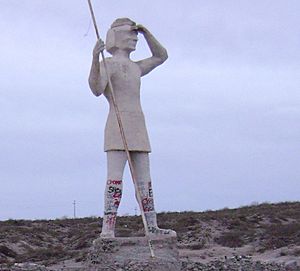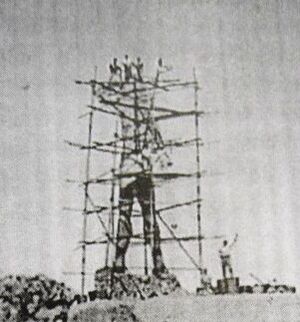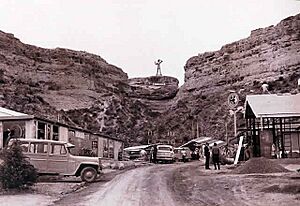Indio Comahue Monument facts for kids
| Monumento al Indio Comahue | |
 |
|
| Coordinates | 39°5′27.64″S 67°4′40.11″W / 39.0910111°S 67.0778083°W |
|---|---|
| Location | Villa Regina, Río Negro, Argentina |
| Designer | Miguel de Lisi |
| Material | Reinforced concrete, ceramic brick, iron |
| Height | 12.92 metres (42.4 ft) |
| Beginning date | July 1964 |
| Completion date | September 1964 |
| Opening date | November 7, 1964 |
| Dedicated to | Native inhabitants of the Comahue |
The Monumento al Indio Comahue (which means Monument to the Comahue Indian) is a special statue in Villa Regina, a town in the Argentine province of Río Negro. It was built to honor the native people who lived in the Comahue Region. The monument was finished just in time for the first Comahue National Fair in 1964.
Bartolo Pasin and Rogelio Chimenti, who organized the fair, asked Miguel De Lisi to design it. A local builder named Aldo Cardozo constructed it in only two months. Today, people use the monument as a lookout point because it offers amazing views. It's a very important symbol for the town and even appears on Villa Regina's official coat of arms.
Contents
Why the Monument Was Built
The Monument to the Comahue Indian was created to remember and honor the native people of the Comahue area. It was built for the very first Comahue National Fair in 1964. This fair was a big event that lasted 45 days. Its main goal was to show off all the great things the Comahue Region could offer. It also celebrated Villa Regina's 40th birthday.
The fair's organizers, Bartolo Pasin and Rogelio Chimenti, saw Miguel De Lisi's work in another city. They were so impressed that they asked him to design this important monument.
How the Monument Was Built
Miguel De Lisi sent his plans to the local building team. This team was led by Aldo Humberto Cardozo and Alberto Sartor. The monument was first planned to be 10 meters (about 33 feet) tall. But Cardozo made it taller, nearly 11 meters (about 36 feet). He also added a 2-meter (about 6.5 feet) tall base. So, the finished monument stands almost 13 meters (about 42.4 feet) high. It shows a native person holding a long spear and looking out at the horizon.
Work on the monument began in July 1964. The main structure was made of reinforced concrete. It had a strong iron frame inside, like a skeleton. This frame was made of thick pipes and reinforced with metal sections. The lower part of the statue was filled with ceramic bricks and concrete. The top half was finished with a layer of reinforced concrete.
The monument was completed in just two months. It weighs about 80 tons! To build it, workers used 500 bags of cement, 2,500 kilograms (about 5,500 pounds) of iron, 60 meters (about 197 feet) of steel, and 80 square meters (about 860 square feet) of sand.
After construction, a local artist named Carlos Basabe Cerdá painted the monument. This was a tough job because strong winds kept blowing the wooden planks off the scaffolding. A building team had to tie the planks down to solve the problem. The painters first put on a special primer coat. Then they added linseed oil, varnish, and finally a shiny copper glitter coat. The monument was officially opened on September 7, 1964, during the start of the Comahue National Fair.
The Monument and Villa Regina
The monument stands on a hill north of the town. This hill is about 70 to 80 meters (230 to 260 feet) high and is covered in bushes. You can reach the monument by two different paths. Today, it's a popular spot for its amazing views of the town. It also marks the finish line for an annual trekking race called "Desafío al Indio Comahue" (Challenge to the Comahue Indian).
The Indio Comahue monument is seen as the main symbol of Villa Regina. It is even shown on the city's official coat of arms. The monument was also featured on an older seal of the Río Negro Province. The Comahue National Fair, which inspired the monument, was brought back in 2004. It is now celebrated every two years.
See also
 In Spanish: Monumento al Indio Comahue para niños
In Spanish: Monumento al Indio Comahue para niños



